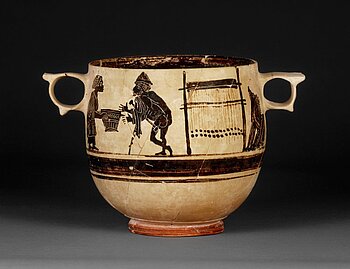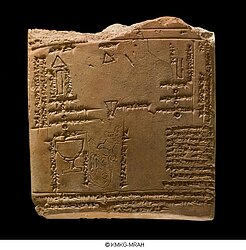Mesopotamian Magic
HEALING & HARMING: MESOPOTAMIAN MAGIC
From mageía to magic
The roots of magic, one could argue, lie in the ancient Near East. The Greek word mageía owes its existence to a loanword from an ancient Near Eastern language; thus one might expect a study of ancient Near Eastern rituals and incantations to lead directly to the core of what is meant when rituals, ceremonies or treatments are called magic. However, as is often the case, the origins of the term magic are specific; in fact, they hardly overlap with what we would regard as ancient Near Eastern magic. Moreover, from the very beginning, mageía is not a word that objectively refers to ancient Near Eastern practices, but a term that carries a value judgment prompted by Greek perceptions of the Middle East. Therefore, the origins of ‘magic’ may well be regarded as an early example of ‘Orientalism’, and, characteristically, a blend of fascination, contempt and misunderstanding has accompanied the concept of magic ever since its inception.
Early on Greek authors used the term mágos, a direct loan from Old Persian maguš, not only as a designation for Iranian experts in religious matters, but also as a pejorative term for ritualists whose practices, in the author’s view, lack piety. Derived from mágos, the term mageía soon ubiquitously carried the same polemical connotation. Usually it served as a derogatory label for ritualistic activities that are, by using this designation, characterized as obscure, irrational and impious. Ultimately, in this line of argument, mageía is a powerful deception performed by shrewd practitioners on their immature, credulous victims.
Magic, science, religion
Ultimately based on its use in Greek sources, magic became, especially in anthropology and the history of religions, one of the three main paradigms of describing and classifying the interaction of men with their environment. To this day the triad of magic, science and religion provides a powerful heuristic framework for organizing the study of past and contemporary cultures: science is concerned with rational, empiricism-based human endeavour producing objective, verifiable knowledge, while the sphere of religion encompasses all phenomena associated with the worship of the divine including theology and ethics; magic, however, is the wayward (and therefore often secret) child spawned by science and religion, combining the latter’s credulous engagement with the supernatural with the former’s belief in the unlimited power and effectiveness of human actions.
Especially students of pre-classical and non-European cultures have criticized this approach ever since, pointing out that the three categories neither adequately reflect the actual structure of the relevant segments of such cultures nor correspond to the conceptualizations of these segments that were produced within the given culture. Students of magic in particular have argued that the term ‘magic’, intrinsically tied to its pejorative connotations and common misconceptions, should be avoided altogether or, at least, be reserved for practices that were regarded with disdain within the culture under study.
What is magic?
Abandoning the use of categories like ‘magic’ altogether would soon prove to be unworkable, and, more importantly, would not do justice to the differentiated views all societies have on the rituals and therapies performed within them (whether these differentiations agree with the presuppositions implied in our heuristic instruments is a different matter).
It may be acceptable to describe magic as an activity that consists in symbolic gestures, usually accompanied by recitations, performed by an expert (relying in his performance on transmitted knowledge) with the goal of effecting an immediate change and transformation in the object of the activity. The actual techniques, texts and symbols involved in the magic activity may differ depending on the cultural context and the purpose of the performance; the activity may be socially acceptable or prohibited; gods may be invoked or ignored; symbolic gestures may be combined with a physical and pharmacological treatment of the patient or stand on their own; the expert in charge may be a high-ranking, well-educated professional or an illiterate healer relying on orally transmitted specialist knowledge—the activity is still essentially the same, and may justifiably be called magic.
Rituals, incantations, cuneiform tablets
Clay tablets inscribed in the cuneiform script are the main (though not the only) sources that provide information on the ideas associated with magic in ancient Near Eastern societies: Letters that formed part of the correspondence between kings and their officials give insight into the relationships at court and supply particulars on quarrels and conflicts that ended in witchcraft accusations. Legal texts, such as law collections, documents, loyalty oaths and treaties, shed light on which ritual practices were prohibited and how their performance would be punished. Lexical texts give important information on the terminology for magic and witchcraft in the various ancient Near Eastern languages. Myths contribute to a better understanding of the role the gods play in magic rituals.
But, and this is true for all ancient Near Eastern societies, the most significant and numerous sources are ritual instructions, prescriptions and incantations that were recorded and copied by ritual experts or other scribes who added them to their private libraries or produced new copies for larger, usually royal, tablet collections.
Mesopotamian magic: āšipūtu
Sumerian and Akkadian ritual and incantation texts were associated in ancient Mesopotamia (Babylonia in southern Iraq and Assyria in the north) with one specific profession, an expert called in Akkadian āšipu or mašmaššu, conventionally translated as “exorcist”; the body of texts itself could summarily be referred to as āšipūtu “exorcistic lore” or, simply, “magic”. Babylonian tradition considered this corpus of texts to be of great antiquity, ultimately authored by Enki-Ea himself, the god of wisdom and exorcism.
Mesopotamian magic can be subdivided into four major categories:
- liminal magic, by which the ritual client or the ritual object is transformed and taken to another status;
- defensive magic, by which an evil that has beset (or threatened to beset) the ritual client is removed and repelled;
- aggressive magic, by which the ritual client gains superiority, strength and attractiveness;
- witchcraft, an illegal and aggressive form of magic by which the ritual client has been harmed.
The last category may be called ‘black magic’, the two categories named first ‘white magic’, while aggressive magic falls into a grey area in between. The vast majority of the transmitted ritual texts belongs to the first two categories; the transition from impurity to purity plays a central role in both of them. Ritual texts for performing illegal witchcraft were not transmitted. But information on the concepts and ideas associated with what was considered to be witchcraft can be gleaned from the body of defensive anti-witchcraft rituals and some aggressive rituals within the lore of the exorcist.
© Daniel Schwemer 2014 (CC BY-NC-ND license)







